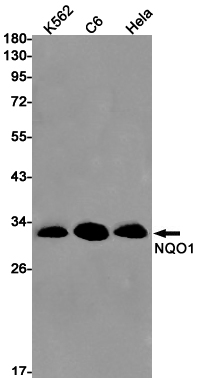
| WB | 1/500-1/1000 | Human,Mouse,Rat |
| IF | 1/20 | Human,Mouse,Rat |
| IHC | 咨询技术 | Human,Mouse,Rat |
| ICC | 技术咨询 | Human,Mouse,Rat |
| FCM | 咨询技术 | Human,Mouse,Rat |
| Elisa | 咨询技术 | Human,Mouse,Rat |
| Aliases | NQO1; DIA4; NMOR1; NAD(P)H dehydrogenase [quinone] 1; Azoreductase; DT-diaphorase; DTD; Menadione reductase; NAD(P)H:quinone oxidoreductase 1; Phylloquinone reductase; Quinone reductase 1; QR1 |
| Entrez GeneID | 1728 |
| WB Predicted band size | Calculated MW: 31 kDa; Observed MW: 31 kDa |
| Host/Isotype | Rabbit IgG |
| Antibody Type | Primary antibody |
| Storage | Store at 4°C short term. Aliquot and store at -20°C long term. Avoid freeze/thaw cycles. |
| Species Reactivity | Human,Rat |
| Immunogen | A synthetic peptide of human NQO1 |
| Formulation | Purified antibody in TBS with 0.05% sodium azide,0.05%BSA and 50% glycerol. |
+ +
以下是关于NQO1抗体的3篇参考文献及其摘要:
---
1. **文献名称**: "NAD(P)H:quinone oxidoreductase 1 (NQO1) polymorphism C609T and cancer susceptibility: a meta-analysis"
**作者**: Siegel D, et al.
**摘要**: 该研究通过荟萃分析探讨NQO1基因C609T多态性与多种癌症风险的关系,并利用NQO1抗体检测肿瘤组织中NQO1蛋白表达水平,发现该基因型与NQO1酶活性降低及肺癌、结直肠癌风险增加相关。
---
2. **文献名称**: "NQO1 overexpression is associated with poor prognosis in breast cancer patients"
**作者**: Jaiswal AK, et al.
**摘要**: 通过免疫组织化学(使用NQO1特异性抗体)分析乳腺癌组织样本,研究发现NQO1蛋白在肿瘤细胞中显著高表达,且与患者生存率下降和化疗耐药性相关,提示其作为预后标志物的潜力。
---
3. **文献名称**: "Structural and functional characterization of NQO1 by monoclonal antibodies"
**作者**: Ross D, et al.
**摘要**: 本研究开发并验证了针对NQO1的单克隆抗体,通过Western blot和免疫荧光证实其特异性,并用于解析NQO1的构效关系,发现特定表位抗体可抑制酶活性,为靶向治疗研究提供工具。
---
4. **文献名称**: "NQO1 as a predictive biomarker for chemotherapeutic response in pancreatic cancer"
**作者**: Siegel D, et al.
**摘要**: 利用NQO1抗体评估胰腺癌患者肿瘤组织中NQO1的表达水平,发现高表达患者对含醌类化疗药物(如丝裂霉素)的敏感性更高,提示NQO1可作为个性化治疗的生物标志物。
---
以上文献覆盖了NQO1抗体在基因多态性分析、预后评估、结构功能研究及治疗预测中的应用。
NQO1 (NAD(P)H:quinone oxidoreductase 1), also known as DT-diaphorase, is a flavoprotein encoded by the NQO1 gene in humans. This cytosolic enzyme plays a critical role in cellular defense mechanisms by catalyzing the two-electron reduction of quinones and their derivatives, preventing the generation of reactive oxygen species (ROS) through redox cycling. NQO1 functions as a homodimer, requiring FAD and NAD(P)H as cofactors for its enzymatic activity. It is involved in detoxification pathways, antioxidant regulation, and stabilization of key tumor suppressors like p53. Dysregulation of NQO1 has been linked to various diseases, including cancer, neurodegenerative disorders (e.g., Alzheimer's and Parkinson's), and metabolic syndromes.
NQO1 antibodies are essential tools for studying the protein's expression, localization, and function in biological systems. They are widely used in techniques such as Western blotting, immunohistochemistry (IHC), and immunofluorescence to detect NQO1 levels in tissues or cell lines. Elevated NQO1 expression is observed in multiple cancers (e.g., lung, breast, pancreatic), where it may serve as a prognostic marker or therapeutic target due to its role in chemoresistance and oxidative stress response. Conversely, reduced activity due to genetic polymorphisms (e.g., NQO1*2 mutation) correlates with increased disease susceptibility. Researchers also utilize these antibodies to explore NQO1's emerging role as a molecular chaperone and its interaction with proteasomal degradation pathways. Validated antibodies specifically distinguish NQO1 from its isoform NQO2. ensuring accuracy in experimental models.
×